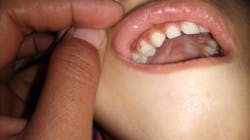Newly discovered "bacterial partnership" significantly increases childhood caries severity
In an “unexpected finding that gives us new insights into the development of caries,” researchers have discovered a previously unknown bacterial “partnership” that can play a significant role in increasing caries severity.
Previously, Streptococcus mutans was noted as the principal cause of dental caries, which affects some 600 million children worldwide. But collaborating researchers from the University of Pennsylvania School of Dental Medicine, the Adams School of Dentistry, and Gillings School of Global Public Health at the University of North Carolina discovered that a bacterial species called Selenomonas sputigena—previously associated only with gum disease—works in partnership with S. mutans, in effect enhancing S. mutans’ ability to cause tooth decay.
Past studies of plaque bacteria have identified other species in addition to S. mutans, including other species of Selenomonas, a group of bacteria that are more commonly found beneath the gum in cases of gum disease. But the new study is the first to identify S. sputigena’s cavity-causing partnership with S. mutans.
The study showed that S. mutans builds sticky constructions called glucans that S. sputigena can become trapped by as they crawl across tooth surfaces with tiny appendages. Once trapped, S. sputigena quickly reproduce, creating "superstructures" that encapsulate and protect S. mutans—an “unexpected partnership” that ultimately significantly worsens caries severity. The bacterial partnership is key; S. sputigena does not cause caries on its own.
To draw their findings, researchers took plaque samples from the teeth of some 300 children ages 3–5 years, half of whom had caries, and later validated their findings on an additional set of plaque samples.
The development “was an unexpected finding that gives us new insights into the development of caries, highlights potential future targets for cavity prevention, and reveals novel mechanisms of bacterial biofilm formation that may be relevant in other clinical contexts," said study cosenior author Hyun (Michel) Koo, DDS, PhD, from Penn Dental Medicine.
In 2022, Koo and his team made a different but also unexpected “crawly” bacterial discovery: a cavity-causing superorganism found in the saliva of toddlers with severe tooth decay that can “crawl” on teeth. The team described the bacteria and fungi that form these assemblages as “developing motions we never thought they would possess: a 'walking-like' and 'leaping-like' mobility.”
Open access study published in Nature Communications: Selenomonas sputigena acts as a pathobiont mediating spatial structure and biofilm virulence in early childhood caries
Primarily sourced from Science Daily: Dentists identify new bacterial species involved in tooth decay
About the Author
Elizabeth S. Leaver
Digital content manager
Elizabeth S. Leaver was the digital content manager for Endeavor Business Media's dental group from 2021-2024. She has a degree in journalism from Northeastern University in Boston and many years of experience working in niche industries specializing in creating content, editing, content marketing, and publishing digital and magazine content. She lives in the Boston area.
